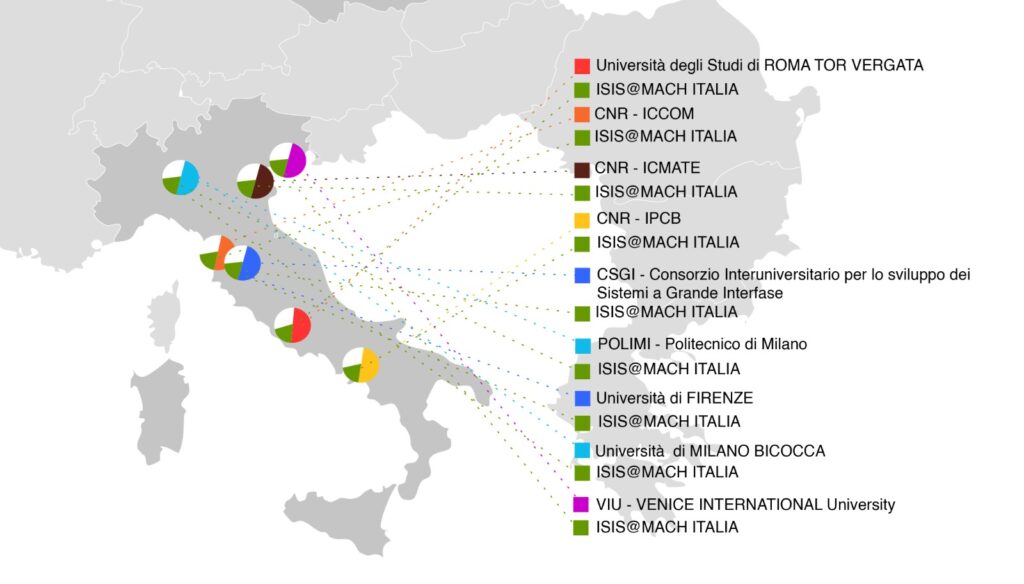About
Apply for Medium-Range FacilitiesCall for Direct Access Round 25-2
Call opens 12:00 CET Monday 5 May 2025
Call deadline 19:00 CET Monday 22 September 2025
The MRF instrument suite of ISIS@MACH ITALIA is free at the point of access for academic and industry researchers, provided the results from experiments are published in the public domain.
The Access Panel meeting for MRF proposals evaluation will take place early October 2025, with results to Principal Investigators (PIs) expected by early November 2025.
The digital User – Hub is the single access point were users can submit experimental and training proposals.
Who we are
The research infrastructure (RI) ISIS@MACH Italia (IM@IT) is a rather unique organisation that provides access to a wide range of small, medium and large scale analytical instrumentation an research capabilities, and the corresponding expertise, for the benefit of many different areas of scientific research, from life sciences to engineering and including industry.
A particularly unique feature of IM@IT is in providing a research pipeline from small research facilities (SRF – of which many universities will have some, but not all), to medium range facilities (MRF – which are more specialised collections of equipment) and then to large scale facilities (LSF – highly specialised infrastructures operated nationally or internationally).
Many researchers, if they do not have prior experience, find that the highly competitive access to LSF is a high barrier, even if it could be very beneficial to their research. IM@IT aims to reduce this barrier, which not only benefits the research but also enables Italy to get better value from those LSF that it contributes to financially such as for example ISIS Neutron and Muon Source (UK) and the Institut Laue Langevin.
The precursor to IM@IT was first established in 2019 as a small scale collaboration between the University of Rome Tor Vergata and ISIS, based on funding from Regione Lazio and building on a collaboration between ISIS and CNR that started in 1985. In the 6 years since 2019, and especially considering the constraints imposed by the pandemic in 2020 and 2021, IM@IT has developed rapidly, exceeding many of its original goals. There is now a distributed network of 7 different laboratories in Italy, and one in the UK, providing access to an extensive catalogue of over 100 SRFs and 42 MRFs. The areas of research range from healthcare to energy materials to cultural heritage. There has been a significant and steady growth in the number of users supported, from 33 in 2022 to 156 in 2024. Over that period 550 proposals have been allocated 1300 days of experimental and training time.
The users’ first contact with IM@IT is through a dedicated helpdesk portal with informative documentation on instrumentation and related techniques and IT tools for data acquisition and analysis. Through the USER HELP DESK portal users discuss and negotiate with a team of multidisciplinary pools of expertise (PoE) in the field of their interest, and build a personalized access program. STEM and communication experts address users to the suitable PoE or instrument scientist, who collaborate with and/or assist users for the writing of an instrument, service or training combined access proposals.
ISIS@MACH ITALIA Research Infrastructure, the hub of ISIS Neutron and Muon Source (UK), [MUR official registry U. 0008642.28-05-2020 – 16th April 2020]. IM@IT is listed in the Italian Ministry of University and Research’s Piano Nazionale delle Infrastrutture di Ricerca (PNIR 2021-2027) “in the broader notion of ISIS”, and ISIS Facility and IM@IT are jointly listed in high priority RI’s (see Table 6 page 30, note 38, PNIR in 2021-2027).
IM@IT Stakeholders
Search Location

